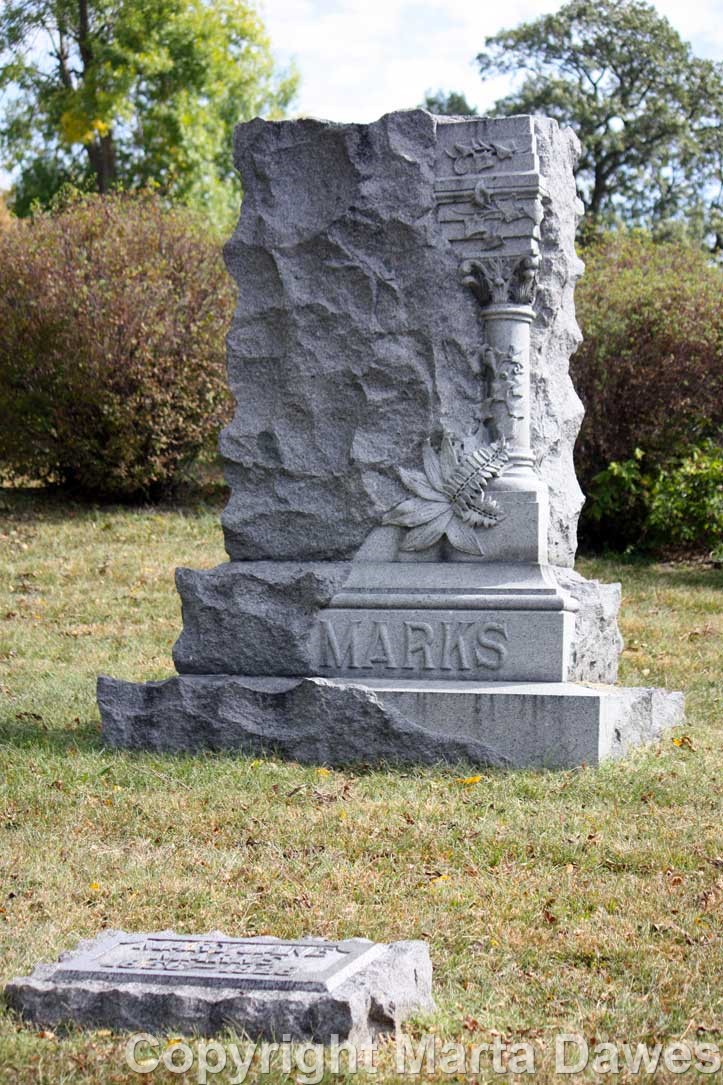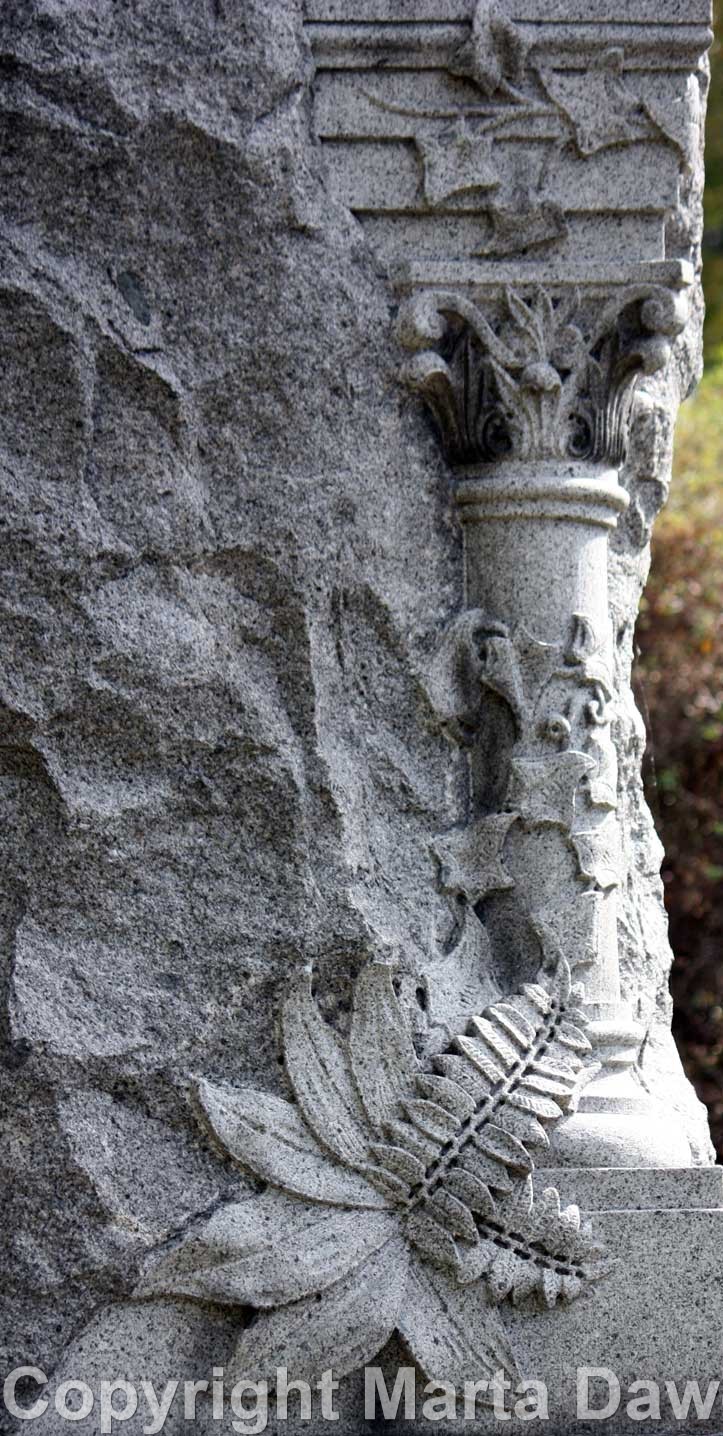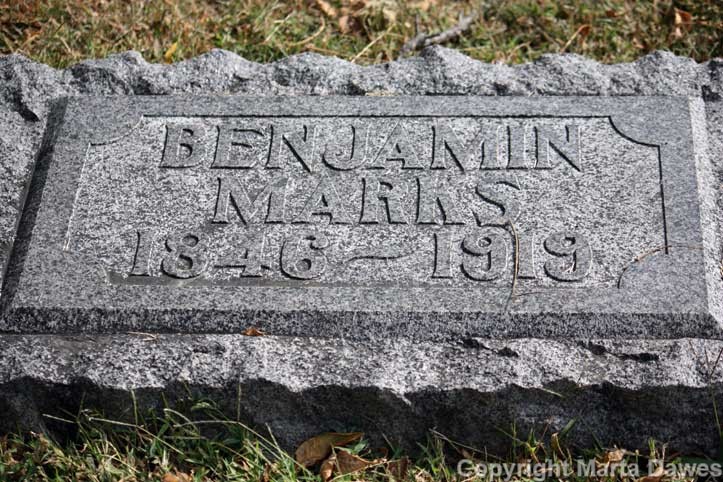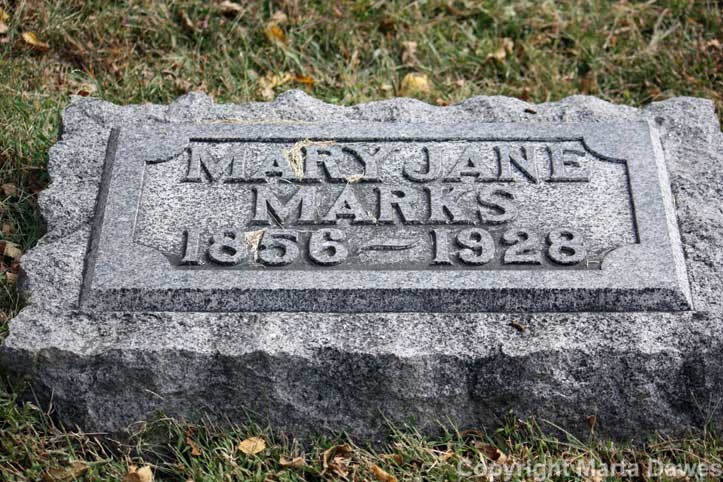

To navigate the Fairview Cemetery pages, use the menu dropdown at the top of each page
Thanks to Ryan Roenfield, we will all know a little more about the Marks family. He sent me the text of a speech he gave to the Pottawattamie County Historical Society, as well as the 1999 Iowa History Forum, and has allowed me to share it with everyone. It's below the pictures.




Benjamin and Mary Marks' Hog Ranch
By Ryan Roenfeld
Western Historic Trails Center
State Historical Society of Iowa
Of all the people that walked the dusty streets of early day Council Bluffs, few carried the significance of the city's own infamous "sportsman," Benjamin Marks. Of course, unless you knew him, and most people in town seemed to, you might walk right past and not even notice his unassuming appearance. The Omaha World-Herald once described him as having "expressionless eyes of blue, sandy hair, sandy complexion…wore something of a beard. He never sported jewelry nor looked anything more than a farmer." Indeed, he was listed in at least one Council Bluffs directory as a "Farmer and Stockraiser," and at the time of his death he owned extensive farmland in Iowa, Nebraska, and South Dakota. However, Marks true profession was that of professional gambler, occasional grifter, and perhaps a bit more. Nine years after his death, the World-Herald remarked that Marks was "believed to have the power to make and unmake men politically" and noted his reputation as a "gambler, philosopher, a good judge of men, land, and horses…". His obituary in the Council Bluffs Nonpareil also commented that Marks was a "power in politics at one time." Millard Filmore Rohrer, a former Pottawattamie County Deputy Sheriff who served a term as Council Bluffs Mayor during the 1870's, later said that Marks' always had an interest in the city's progress and had donated some of his land to the city's park system. In Council Bluffs, Marks had the reputation as someone who offered a "square deal" to those who liked their entertainment provided by Lady Luck. Other sources establish him as a notorious confidence man and fixer who bilked millions of dollars during his lifetime and trained countless other con-men who were "later to become notorious on the rag, the wire, and the pay-off."
Now Benjamin Marks was born in 1848 at Little Fort, Illinois, about 50 miles north of the Chicago Loop. Coincidentally, Marks was born just 15 years after the Potawatomi Indian Nation sold that land and moved down to what later became Council Bluffs. The town of his birth, later renamed Waukegan, is the county seat of Lake County and is essentially a suburb of Chicago. Little is known of Marks' early life in Illinois although his obituary reported that at the age of 13 he served as a dispatch bearer during the Civil War.
Like many others, Marks gravitated West when the war ended. There he embarked on his career as a professional gambler and apparent con-artist. Professor David Maurer's seminal study of American confidence men places a 19 year old Marks in Cheyenne, Wyoming in 1867. Cheyenne was the latest in the series of Hell-on-Wheels founded almost overnight during construction of the Union Pacific. General Grenville Dodge, who had platted the city while surveying the Union Pacific, later called Cheyenne "possibly the greatest gambling places ever established on the plains..." Marks arrived in the new Wyoming metropolis with a board slung across his shoulders enabling him to set up a three-card monte game anywhere and make an equally fast getaway. A fast getaway was important for anyone dealing monte since, of course, the game is an absolute scam. Known as "Find the Lady" in England and Bonneteau to the French, three-card monte seems relatively simple to the uninitiated: the dealer, called the Tosser, shuffles three cards face down and the player, after placing his bet, simply has to point out where the Queen card lies. Of course, the dealer always has the game rigged somehow so that there is no chance whatsoever of any player winning. Even those that do appear to win a few dollars are just shills in league with the Tosser to make it seem that the game can be beaten.
Marks quickly discovered that he was far from the only one tossing three-card monte and this great chiseling competition at Cheyenne forced him to invent a new outlet to practice his trade. As Maurer put it, Marks had an "idea which was eventually to revolutionize the grift, an idea which was to become the backbone of all big-time confidence games." This simple idea was the Dollar Store where the front window showcased a variety of gaudy and useful items all obviously worth more than the advertised dollar. A person's own greed brought them inside where Marks and his cohorts quickly switched the pitch to the three-card monte games conducted on top of barrels. Thus, nothing was ever sold in the Dollar Store but money always seemed to change hands in Marks' favor. According to Maurer, Marks "contributed more than any other one man to the development of the big store….(the) carefully set up and skillfully managed theater where the victim acts out an unwitting role in the most exciting of all underworld dramas."
Another source lists Ben Marks as making his first appearance in Council Bluffs in 1867. The city had grown to almost 10,000 people by the end of that decade and was in the midst of a great railroad building boom with hungry speculators with easy cash on almost every corner. The perfect situation for any confidence man. Like his successful Cheyenne venture, Marks soon set up a scam when he became involved with the Hoffman House located in the 500 block of West Broadway. Marks' operation was on the second floor of the brick building with Charley Poore's Saloon located at ground level. The Hoffman House featured a variety of gambling opportunities with faro being one of the most notable. A gift of the French, faro was the most popular game in the West for high rollers who wanted to "buck the tiger." It's a fast-paced and complicated game where it's quite possible to win or lose hundreds of dollars over a single draw of the cards. A player could bet with the dealer, known as the bank, or against the bank but either way the house had the advantage and an experienced banker could easily swindle the players without them knowing. A typical ruse was "the last turn" in which the player was allowed to run up tremendous bets over what card the dealer would draw out of the card-box next. Marks' faro dealer was a one-handed former safe-blower named Charlie Stebbins whom Professor Maurer considered among the experts at the trade. Gamblers from across the country were attracted to Marks' operation since, "they believed that Ben was square, and they knew that the sky was the limit if they wanted to plunge."
During this time frame of the early 1870's, Marks was in league with a host of notable gamblers and like-minded confidence men that "roosted" in Council Bluffs and Omaha while sweeping riches away from railroad travelers. This motley group included Canada Bill Jones, a master at three-card monte who was known far and wide for his generosity; Doc Baggs; Charley White; George DeVol; the infamous Frank Tarbeaux, and an Englishman named John Bull who had won infamy in the Montana mining towns for shooting his mentor Charlie Peel dead on Helena's Main Street. In the early '70's, Marks, John Bull, Doc Baggs, and Omaha gambler George Mehaffy were all indicted in Omaha for robbing a Missourian after a card game. Worse yet, the Union Pacific banned gambling on its trains after a now nameless company official lost $1,200 to Frank Tarbeaux and "Jew" Mose. Canada Bill Jones even offered the railroad's general superintendent $10,000 a year for exclusive rights to run three-card monte games on U.P. trains if he limited his victims to Chicago businessmen and Methodist preachers. The Union Pacific declined Canada Bill's generous offer and most of the gamblers sought new opportunities in the mining towns of the Black Hills like Deadwood. But Ben Marks remained in Council Bluffs where he used his ill-gotten wealth to establish himself in politics and turn his transplanted home into a "right town," a place where the fix was covered and "con men gathered for both social and business reasons."
Now of course, behind every great man is a great woman and Ben's wife Mary surely qualifies. Born in Center Point, Linn County, IA. in 1856, Mary came to Council Bluffs from Sidney shortly after the couple's 1882 marriage in Chicago. Mary, to whom Ben really owed much of his financial success, became a noted Council Bluffs businesswoman whose upper-class "bawdy house" stood at 223 Vine Street in Council Bluffs where she and Ben also resided. Despite the immoral taint of her profession, Mary was evidently a well-respected woman in the community. One of the most famed stories about her, and one that we today have no way of knowing actually happened, occurred when the elite society ladies of Council Bluffs encouraged Mary to give up her profession and join their social circle. To this suggestion she supposedly remarked "I can't change my ways. I have done this all my life and I just can't quit. However, it was thoughtful of you to consider me as your equal in society. Now it's getting to be about five o'clock. If you care to wait just a few more minutes, your husbands are upstairs in the bedrooms and they will want to come home."
Of course, at various times reform elements in the city attempted to close down the vice operations that were the Marks' bread and butter. According to local photographer W.R. Mynster, Council Bluffs ministers would get a kindly visit from Ben who would give them a long talking to with occasional quotes the scripture and one would assume liberal financial contributions. With "plain or garden reformers," Mynster told the World-Herald that Marks' favored resolution was to go to their office "and be sure you are alone. Then tell him that you are sorry he is acting the way he is, and if he acts different it will be to his advantage-if not it's apt to cause a lot of trouble. If he gets big and blustery, just get up and go over and shove a gun in his ribs. Then tell him in plainer and more forceful language. Promise to come back if necessary, and if he has been a sinner tell him about it. Be convincing, and prod him a bit with the barrel."
Around 1886, the Marks interests turned south of Council Bluffs to the ox-bow lake left by the Missouri River after the Great Flood of 1881. Marks began purchasing large amounts of land for future enterprises, including property later incorporated into Lake Manawa State Park. The 1,000 acre estate conveniently straddled the Pottawattamie and Mills County lines and was known as "Elk Grove" after the herd of tame elks the Marks kept.
The centerpiece at Elk Grove was the Marks' infamous log cabin still remembered today as the Hog Ranch. Originally erected as the Minnesota Pavilion at Omaha's gala 1898 Trans-Mississippi Exposition, the building supposedly contained a log from every state in the Union. At the end of the Exposition, Marks bought the structure for a reputed 60,000 dollars, took it apart and numbered the logs, and then had it floated down the Missouri to Elk Grove where it was rebuilt as a luxurious three-story ranch, casino, and brothel.
According to legend, Marks had the cabin intentionally rebuilt right on the county line to avoid any potential problems. All the rooms were interconnected and any raid could be avoided by moving to a different room and thus into a different Sheriff's jurisdiction. In addition, the building was surrounded by a moat on three sides thanks to the old channel of Mosquito Creek, with a fifteen-foot tall electric fence on the fourth. The first floor of the ranch contained the casino area, on the second floor were six bedrooms, including Ben and Mary's master bedroom with five smaller rooms for the prostitutes, and the third floor ballroom had a balcony looking west towards the sluggish brown waters of the Missouri.
The grounds at the ranch featured the resident elk and also contained a mile long horse-track that was sometimes used for foot races as well as a boxing ring. One of the first boxing matches held at the location took place in July 1897. The fight featured Middleweight boxing champion of the Pacific Coast, Charlie Goff, squaring off against the Ruhlin, the Ohio Giant. The event was attended by just 10 sportswriters although the low attendance was either because nobody believed such notable sports figures would actually show up or the sportswriters were simply being scammed. Probably only Marks knew for sure. At the time, Marks employed such smooth-talking ropers as the Honey Grove Kid, Crazy Horse Thompson, and George Ryan. These ropers would lure people on trains or at the several Council Bluffs railroad stations, people traveling with money, people that would be on their way somewhere else soon enough, people that to this day are still known as "marks".
In addition to the income from gambling and prostitution and sporting matches, the Marks Ranch was also a large-scale farming operation. An Iowa girl at heart, and with extensive experience managing another sort of stable, Mary served as the farm manager helping to raise the livestock and supervising the hired hands. This provided the couple a steady income in the up-and-down world of professional gambling.
Another Marks enterprise was located right in the heart of the Manawa Park amusement and resort complex that had grown up on the north shore of the lake during the 1890's. In 1906, Marks' clubhouse took up the second floor of the Council Bluffs Fish and Game Association building, an organization still in existence. Marks' Manawa clubhouse featured roulette wheels, craps tables, a variety of card games, and slot machines. This casino was also installed with trapdoors into the basement for those who became "too abusive or obnoxious due to too much whiskey, or cheated at the gaming table." One can be sure that those who attempted to cheat Marks never had the opportunity again. Marks was also known to keep a close eye on his own employees with special peep-holes in the ceiling at the Hoffman House that allowed supervision of dealers just in case they were tempted "to go South" with Marks' loot.
Marks' concern on the north shore of Manawa came to an end in 1913 when the cataclysmic Easter tornado tore across Council Bluffs and Omaha. The tornado killed over 100 people, including 17 in Council Bluffs. On its way through the Manawa area the tornado leveled Marks' casino and several other Manawa attractions including the Kursaal bathhouse at Manhattan Beach and the Shady Grove Picnic Grounds.
That same year, Marks' farm at Elk Grove was taken over by a gang headed by John C. Mabray or Maybray. In spite of Marks' local reputation for honesty, the Mabray Gang were nothing more than a bunch of swindlers. Perhaps the 65 year old Marks' judgement had suffered from the chronic liver disease he developed around 1908 or he just forgot the cardinal rule that you can get away with a hell of a lot in Council Bluffs, Iowa unless you mess with the locals. In any case, the Mabray gang bilked an estimated five million dollars off crooked gambling games and fixed races and boxing matches held at the Ranch. After one jockey was killed for refusing to throw a race, the United States Attorney moved in and indicted 84 gang members in what Maurer called a "purge." Those caught in the sting included pugilists Clarence Glass, Clarence and Harry Forbes, and Ed McCoy; wrestlers and steerers Ed Leach, Tom Robison, George "Ole" Marsh, and Bert Shores; and horse jockey Willard Powell. Charges were brought against Marks as well although a local jury acquitted him of any wrong- doing.
Five years after the Mabray indictment Benjamin Marks died at the age of 71 at his Council Bluffs home on Vine Street from the liver ailment in spite of the fact he was not known to drink much alcohol. Although the resident Minister was absent from the proceedings, Marks' funeral services were held at the Broadway Methodist Church, a faith he apparently converted to in the last few weeks of his life. According to Council Bluffs undertaker Ben King, it was "one of the most terrific funerals Council Bluffs ever had." Benjamin Marks was then buried in the city's Fairview Cemetery on the bluffs overlooking the Missouri River Bottoms. Other than Mary, Marks' was also survived by a daughter, another source said sister, named Josephine who lived in Waukegan. After the funeral, Mary Marks sold her local assets and moved to Kansas City, then Denver and Florida, and finally settled in Los Angeles. About 20 acres of their Elk Grove estate was purchased by Wallace Benjamin and Company who intended on dividing the land into lots for the Lakoma plat of Manawa while most of the contents of the house were auctioned off.
In 1922, the Marks' log ranch was purchased by Iowa native and oil millionaire Berne Hopkins. Hopkins' goal was to transform the estate into an authentic "Hog Ranch" with plans to produce five million pounds of pork a year. Hopkins' had constructed a $50,000 dairy barn, five miles of water lines to the farrowing houses, a ranch house for the farm manager, and a three story bunk house for the hired hands. It took just a couple years though for the truculent Missouri to force Hopkins and his wife Portia out of the 16 room log mansion. Hopkins then traded the Hog Ranch to a Missouri consortium in exchange for the Peacock Apartments in Kansas City. Hopkins' fortune was eventually depleted by the Internal Revenue Service and he spent the last years of his life on a 20 acre farm in Colorado.
The end of Elk Grove came in March, 1925 when the Missouri firm of Jones and Weaver held a three day auction to dispose of the Hog Ranch property. The estate was divided into six farms which sold for about $135 an acre. Joe Branson of Lincoln purchased the grounds containing Marks' cabin for $298 an acre. Hopkins' extensive stable of thoroughbreds was also auctioned off, including a champion Belgian stallion, but the proceeds were conceded to be far below the expectations.
Three years later in 1928, the year the Manawa Park Resort closed its gates for good, Mary Marks died from diabetes in Los Angeles just a few days shy of her 72nd birthday. Her body was shipped back to Council Bluffs and funeral services were held at the Broadway Methodist Church before her burial beside Benjamin. A half-sister of Mary's in Chicago named Ida Gregson contested the disposition of the estate estimated at $25,000. Although the court ruled against Mrs. Gregson's claims, in the end she received the lion's share of the money. Other beneficiaries from Mary's will included $500 to the Broadway Methodist Church, a smaller amount to the Christian Home Orphanage in Council Bluffs still in operation today as Children's Square U.S.A., her half-brother John McMullen of Omaha received $1000 while his daughter Irma got $500, Rex Wightman of Sidney, IA. got $200, and $500 went to Mary O'Neill, manager of the millinery department at John Beno's department store in downtown Council Bluffs.
Meanwhile, the Marks' Ranch went through a succession of owners and spent occasional years uninhabited except for the squirrels and raccoons. In 1949, the property was purchased by Gerald Mullen. Three years later the Flood of 1952 came along and the Missouri's waters rose four feet above the first floor level. In 1957, the property was purchased by Earl Root. In the early 1970's the first attempts were made to establish the ranch as a historic site and possible tourist attraction. This never materialized. A Mills County Supervisor once told me that the County Conservation Board had the chance to buy it for a few hundred dollars. But they didn't.
In the meantime, the Vine Street neighborhood where the Marks' elegant home and brothel sat was totally transformed as part of the 1970's Urban Renewal of downtown Council Bluffs. The location of the Hoffman House and Charley Poore's Saloon had been torn down much earlier and until very recently was the location of the Council Bluffs Savings Bank. However, the old Marks' Ranch at Elk Grove still sits just south of Council Bluffs along a dusty gravel lane named Applewood Road surrounded on all sides by acres and acres of soybeans and corn. Although the cabin has deteriorated over the past century it still stands as perhaps the last reminder to the legacy of Benjamin and Mary Marks, one of the most unique couples to ever call the city of Council Bluffs and the State of Iowa their home. Thank you very much.